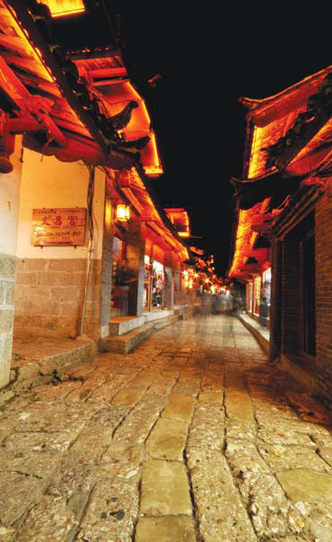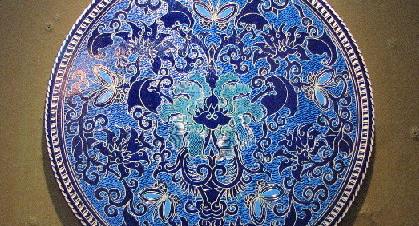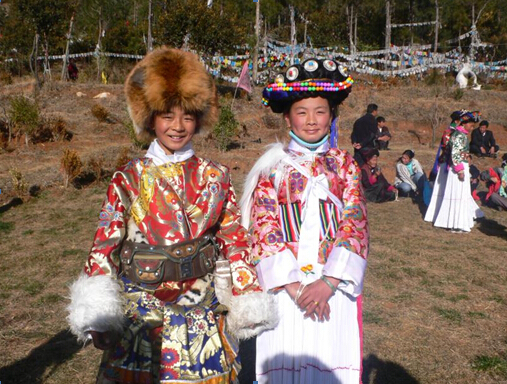Picture perfect
(chinadaily.com.cn)

Lijiang's spectacular alpine scenery attracts millions of tourists
each year. Locals have always regarded the mountains as holy.Wang Huabin/for China Daily

The Old Town comes alive at night with red lanterns
everywhere. Zhong Guilin / for China Daily
The cobbled paths of Lijiang lead to authentic scenes of an old world
Lijiang's stunning natural surroundings have fired many a visitor's imagination about an utopian land of peace and unspoiled natural beauty. Some have speculated this ancient town may have inspired James Hilton when he created the town of Shangri-la in his famous novel Lost Horizon. The city of 1.3 million is extremely popular among Chinese tourists and rests south of the Qinghai-Tibet Plateau in Southwest China's Yunnan province.
The far-off snow-capped Yulong Mountain provides a spectacular backdrop to the Old Town, which features zigzagging cobbled streets, swaying willows and crisscrossing canals that glow from red lanterns at night.
It is very hard to take a bad photograph in this romantic destination. At sunset, the ubiquitous red lanterns create a red hue across town, adding to the colorful nightlife. One can leisurely sit in one of the many two-story wooden bars while sipping Pu'er tea or something stronger, and often the sounds of Naxi girls singing traditional folk songs can be heard.
In 1997, UNESCO listed Lijiang, together with Pingyao, as China's first World Cultural Heritage Cities.
The Old Town has many attractions but the surrounding area offers so much more for the intrepid traveler.
1. Old Town
The 800-year-old Old Town is called the "Venice of the Orient" and has been the home of the Naxi people for centuries. It is the only ancient town in China built without a city wall and is noted for its harmony with nature, distinct wooden architecture, and fusion of different cultural traditions.
2. Yulong Mountain (Jade Dragon Snow Mountain)
Rising 5,600 meters above the plains, it is the southernmost glacier in the northern hemisphere and has been regarded as a holy mountain by locals. Travelers can take a cablecar from the foot of the mountain to the summit, where they can enjoy a bird's-eye view of alpine lakes, rivers and the grasslands below. The mountain has the highest ski resort in China and skiing season begins in November and continues through June. The mountain is about a 30-minute bus drive from the city.
3. Shuhe Village
Shuhe Village is situated 4 kilometers northwest of Lijiang Old Town and is famed for the Dragon Spring Village, which has a natural spring. Shuhe is another place which receives world cultural heritage protection and the village seems like a visual extension of Lijiang Old Town.
4. Heilongtan Park (Black Dragon Pool)
The pool gets its name from a legend about a black dragon which lived in this pool. The snow-capped mountains create a spectacular backdrop and images of these majestic formations are reflected in the pool. There is a pavilion, which stands in the middle of the lake and is also beautifully reflected in the waters. Local musicians often play traditional music on the bandstand and the area is a favorite picnic place for people from Lijiang Old Town.
5. Tiger Leaping Gorge
The name comes from another legend about a tiger that once jumped across the gorge at its narrowest section. With a drop of 3,000 meters, Tiger Leaping Gorge is believed to be one of the world's deepest canyons. One can look down and witness incredibly loud, rushing rapids, which furiously pound against giant boulders and the rocky banks of the river. Visits are recommended in spring, when melting snow flows down from the Himalayan mountains and makes the river run wild.
If you go
Flights
There are two flights to and from Beijing every day and a one-way ticket costs 1080 yuan (122 euros). Flying time is nearly four hours. There are also two return flights from Shanghai and the 4.5 hour trip costs 2,550 yuan. Many tourists use Kunming as the transit stop and then go to Lijiang by air, train or bus. A flight takes about 40 minutes and Lijiang airport is about 28 kilometers from town.
Climate
Lijiang has marked wet and dry seasons. The wet season spans May to October with plenty of rainfall. From November to April it is dry season. Autumn is the best time to visit Lijiang, when temperatures are pleasant and rain is rare. July and August are less desirable months with most rainfall and occasional lightning storms occurring during this period. January and February is the time when the wintry weather comes to its climax. But if you like a snowy scene, visit between January and March.
Souvenirs
Yak horn combs
Burned wood carvings
Buttered Tea
Lijiang Snow Tea
Xing Liquor (a nutritious liquor with low alcohol)
Li Yin (hand-crafted silver ornaments)
Naxi bracelets and necklaces carved with ancient Dongba hieroglyphs
Local food
Yak's milk yogurt
Naxi fried white cheese
Baba (a flat wheat bread)
Entertainment
Nightlife: Xinhua Street is a famous bar street that runs along the waterways in the Old Town
Naxi Concert Hall: Hosts a daily traditional Naxi music show performed by the Naxi orchestra
Dongba Palace: Another famous place for Naxi traditional music performance
Tips
Because Lijiang is 2,400 meters above sea level, this may affect some tourists from low-altitude areas. Altitude sickness pills are an easy solution.
Except for summer, the temperature difference between day and night can range from 5-18 C so it is a good idea to carry a jacket.
The high elevation leads to abundant sunshine all year round, so don't forget to bring your sunscreen, sunglasses and a hat to avoid sunburn.





